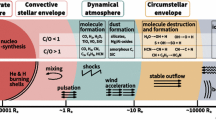Abstract
Assuming that a disk galaxy is composed of an ambient pervasive gas, small clouds, molecular clouds and stars, its evolution is studied through examining the interchange processes among them. Main results obtained are: (1) The star formation rate is directed by the formation process of molecular clouds. (2) Depending upon the parameters there may be three or four types of evolution of disk galaxies: the no star formation case, the active in the past and inactive at present star formation case, the burst-like star formation case and the very active in star formation case.
Similar content being viewed by others
References
Habe, A., Ikeuchi, S., and Tanaka, Y. D.: 1981,Publ. Astron. Soc. Japan 33, 23.
Ikeuchi, S., Habe, A., and Tanaka, Y. D.: 1984,Monthly Notices Roy. Astron. Soc. 207, 909.
Jog, C. J. and Solomon, P. M.: 1984,Astrophys. J. 276, 114.
Author information
Authors and Affiliations
Rights and permissions
About this article
Cite this article
Tanaka, Y.D., Ikeuchi, S. & Habe, A. Evolution of disk galaxies regulated by supernova remnants. Astrophys Space Sci 119, 207–210 (1986). https://doi.org/10.1007/BF00648848
Received:
Issue Date:
DOI: https://doi.org/10.1007/BF00648848




